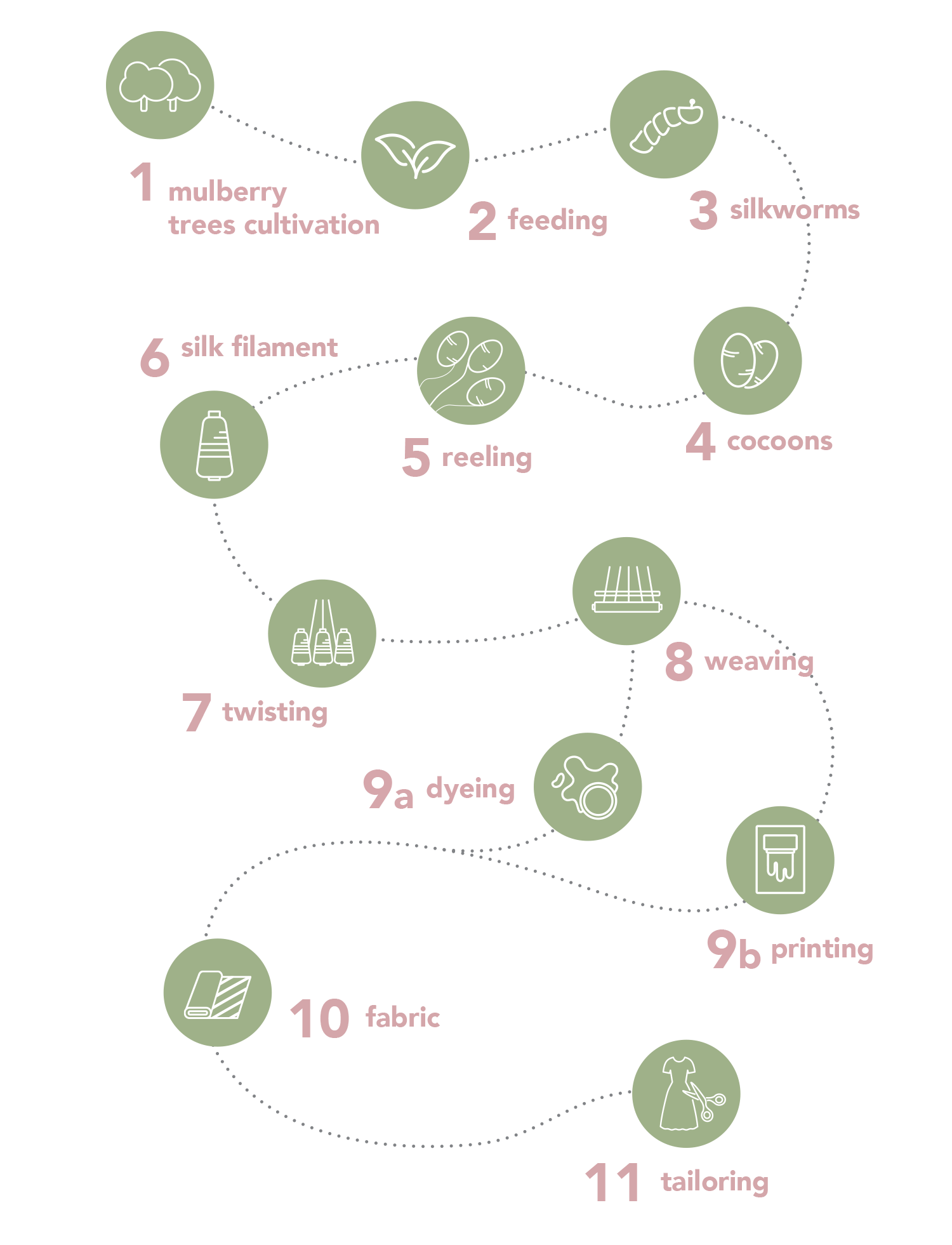
SILK
With a millennial history, silk is a fiber that respects the environment.
Silk is a material that merges all of the features proper of a comfortable and transpiring fabric. It is a thermo-regulative material, protecting our body from excessive heat or cold and leaving it dry. Silk is also a hypo-allergenic and anti-bacterial fiber, two qualities that, together with softness and brightness, make it the most imitated fiber worldwide.

A natural fiber
with over 5000 years of history_
Silk is a natural fiber that, since over 5000 years, is still considered as the queen of textile materials. Before being transformed into a textile fiber, it is a bio-polymer produced by silkworms, a lepidopteron named Bombyx mori. This little insect has created such a formidable molecule throughout the thousands of years of its evolution.
The beginning of the coexistence of mankind with silkworms gets lost into the mists of time, and it has always contributed to human civilization. Silk has been the great focal point of the Ancient Chinese Empire, as well as the crucial economic engine and centre of Italian Renaissance. In fact, there would be no sign of the great artistic and cultural development of Florence without the aristocratic families that promoted silk trade. In such a refined and luxurious environment, silk contributed to the change and evolution in taste, design and the cult of fashion, a contribution that is still present nowadays when we look at haute couture.
From the cocoon to the yarn,
a never-ending process_
From the cocoon to the yarn, a never-ending process_

Silk path begins with the cultivation of mulberry trees, which leaves are basic for silkworms’breeding. When silkworms are 7cm long, they produce a continuous filament, a protein that solidifies immediately. Thanks to a peculiar circular movement, silkworms create and shut themselves into the cocoon, which will be later harvested and transformed into the silk yarn. At this point, we have the reeling phase: a set of operations with which we take out the filament. Cocoons are here plunged into hot water as to soften sericin and, with particular spoons, are brushed as to find the head of the filament. From 6 to 7 cocoons are needed to create the common silk filament which, before being used on a loom, is twisted as to give it the desired features. Such features will also determine the characteristics of the fabric that will be weaved later on. The fabric, before being tailored intogarments and accessories, has to undergo further processes: it can be dyed with either acid or reactive colours, and/or can be printed with the most diverse designs.


Silk and
the environment_
Silk has been produced since thousands of years without a negative environmental impact, creating instead a perfect sustainable equilibrium.
The silkworm is an insect that feeds itself with nothing but mulberry leaves so, mulberry plantations are vital for eat. According to the “Carbon Footprint” parameter, silk is the only fiber which, through its entire productive process, generates more oxygen than it consumes; with a hectare of mulberry trees we can produce up to 100-150 kgs of raw silk, but we fix 200kgs of CO2. Mulberry trees catch CO2 and release oxygen through their entire life. These are plants with great adaptation capabilities, they support biodiversity, help fighting against deforestation and uncontrolled land consumption.
A fiber with
countless properties_
Silk has always been associated with perfection: it is even and continuous, soft and delicate. It has a refined hand, luxurious and elegant. Silk is worldly recognised for its bright and shiny aspect, reason for which ancient civilizations considered it extremely precious.
It has a micronage equal only to cashmere and it is able to quickly catch and release humidity, ensuring effective thermo-regulation and hence representing the most suitable fiber for a comfortable garment. These are the reasons why silk is used for a wide range of products: from underwear to padding and bedsheets. Silk is also extremely resistant, more than any other textile material, comparable only with steel.


Properties
and curiosities_
Silk is a highly bio-compatible fiber, that does not generate rejection once it is implanted into a human body. This is why this fiber is extremely used in bio-medicine as concerns tissue therapy and suture strands.
Silk contains a protein, the fibroin, which is able to block molecules of various enzymes within its structure; this is the clue of silk anti-bacterial and odour-prevention actions. Silk is frequently implemented in the cosmetic field as well for creams, gels and serums thanks to its great anti-age and skin reparation properties. When it comes to dermatology, it has been recently discovered how silk is highly therapeutic in this sense thanks to its own structure, very close to our skin structure.
Silk represents a crucial resource in these as well as in other fields. Strings of some musical instruments made with steel and silk, also known as “compound strings”, have greater flexibility and lower tension and allow to create softer and more delicate sounds.
